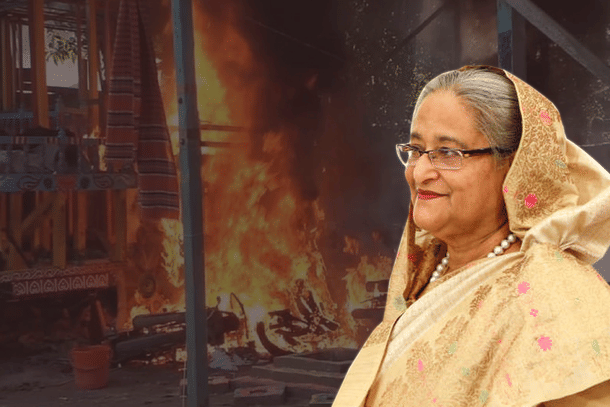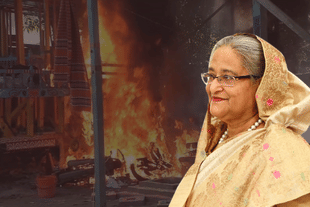World
Bangladesh: India Almost Intervened Militarily To Support Ally Sheikh Hasina In 2009 — Here's The Story
Ujjwal Shrotryia
Aug 05, 2024, 03:16 PM | Updated 03:48 PM IST
Save & read from anywhere!
Bookmark stories for easy access on any device or the Swarajya app.


Violent protests in Bangladesh have intensified further with the latest rounds of fierce clashes taking the lives of hundreds, including 14 police officers.
The protests, which started with students protesting against a 30 per cent reservation in government jobs for children and grandchildren of ‘mukti-joddhas’ (freedom fighters who participated in the 1971 war of independence that liberated the country from Pakistan), are now demanding the resignation of Prime Minister Sheikh Hasina.
The massive protest, coupled with the Bangladesh Army's ambivalent stance and the support given to the protests by many serving and retired officers, has raised dark clouds over the longevity of Hasina's government.
However, this is not the first time that Hasina has faced such a volatile situation.
In 2009, on 25 February, officers of the now-disbanded Bangladesh Rifles (BDR) rebelled and killed multiple senior officers and families of BDR, including its chief.
With a similar ambivalent stance from the army, Hasina, feeling threatened, asked India for help, nearly prompting India to intervene in her favour.
Avinash Paliwal, a senior strategic affairs expert, in his book India's Near East: A New History, writes that "the worst massacre of army officers in Bangladeshi history was underway. Shortly after the killings began, Hasina called her closest ally in New Delhi, top Congress leader and recently appointed finance minister Pranab Mukherjee. Upon hearing what was going on, Mukherjee promised 'to be responsive.' The 'SOS' from Dhaka triggered the mobilization of paratroopers and prompted Foreign Secretary Shivshankar Menon to urgently engage with American, British, Japanese, and Chinese envoys to lobby support for Hasina."
By 26 February 2009, India had prepared a battalion — the 6th Battalion of the Parachute Regiment — to spearhead landing operations in Bangladesh.
By the evening of 26 February, 1,000 paratroopers were stationed at Kalaikunda Air Force Station in West Bengal, awaiting further orders.
Paliwal writes that, apart from Kalaikunda, paratroopers were mobilised in Jorhat and Agartala. "If the order came, Indian troops would enter Bangladesh from all three sides. The aim was to secure the Zia International Airport (now renamed Hazrat Shahjalal International Airport) and the Tejgaon Airport. Subsequently, the paratroopers would wrest control of Ganabhaban, the prime minister’s residence, and evacuate Hasina to safety."
In fact, Paliwal says that the paratroopers were given first-line scale ammunition as well. First-line scale ammunition is a military term that signifies ammunition for active combat.
Paliwal notes that the Bangladesh Army’s ambivalent stance, akin to the current situation, prompted plans to send reinforcements from the Indian Army's Corps in the East.
He says, "If Bangladeshi generals turned against Hasina, they would resist Indian soldiers. If it came to that, we have a whole corps in the east which would have sent reinforcements," quoting Maj Kamaldeep Singh Sandhu of the 6th Battalion of the Parachute Regiment.
Recovering from the 26/11 attacks and the Sri Lankan civil war in its final phase in its south, India could not afford another war in the east, particularly due to pro-Pakistan and pro-Islamist elements in the BDR, says Pinak Ranjan Chakravarty, India's high commissioner to Dhaka from 2007 to 2010.
Chakravarty says that during the BNP-Jamaat rule (Bangladesh Nationalist Party and Jamaat-e-Islami), many Jamaat members were recruited into the BDR as rank-and-file personnel, and were reportedly used by Pakistan.
Paliwal writes, that just as relations with Pakistan hit the lowest ebb after a surge of optimism during the composite dialogue (2004-07), New Delhi could ill afford instability or an adversarial regime in Dhaka.
Even though the mutiny and its international linkages generated much rumour and insinuation, the stakes for New Delhi were too high. With Indian general elections due in May, and the Sri Lankan civil war entering its final stages, Indian policymakers could ill afford Hasina’s dislocation in Bangladesh.
"India almost intervened militarily in Bangladesh on 27 February. But the orders never came," Chakravarty says.
India was extremely serious about the situation and was worried about her safety. Paliwal says that India even threatened Gen Moeen Uddin Ahmed, the then Bangladesh Army chief, against the use of force.
Paliwal further writes, "I was told by those who were closer to power that Gen Moeen was asked not to use force otherwise [Indian] paratroopers will drop in Dhaka within one hour," says Touhid Hussain, then Bangladesh’s foreign secretary.
“India was not bluffing. It was all real... we would’ve intervened if required," confirms a top Indian official who was part of foreign and security decision-making.
The final orders to intervene never came because Paliwal says, "Moeen stepped back from the brink."
Paliwal further writes, “The Prime Minister directed that the crisis should be solved politically and it has been resolved in that manner," announced then Bangladesh Brig. Gen. Mahmud Hussain, the Director of Military Intelligence."
In the end, Hasina held her ground, heard them out, and acted against the mutineers. “It was appropriate that she did that because it had a calming effect,” says Hussain.
Close to 200 mutineers were arrested, the BDR was disbanded, and all the officers who rebelled lost their jobs.
Staff Writer at Swarajya. Writes on Indian Military and Defence.





